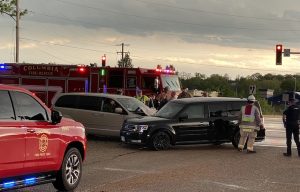Summer camp care for EMS

Pictured, responders move a patient onto a medical sled to take him to a better location after addressing his injuries during a training session last week at Camp Vandeventer.
A number of emergency responders took the first step toward a wilderness care merit badge as they trekked around Camp Vandeventer west of Waterloo last week to practice search and rescue skills.
Michael Gilbert is the assistant chief for St. Clair Special Emergency Services, one of several groups in the wider St. Louis Metro Task Force.
Being in St. Clair County, the group is also part of Illinois EMS Region 4, which also covers Monroe, Randolph and other neighboring counties.
St. Clair County Special Emergency Services consists of four divisions: rescue, hazmat, medical and K-9. This wide coverage is meant to assist healthcare agencies in the region – particularly in disaster relief scenarios.
“We support the entire region of hospitals and any healthcare in any type of disaster or emergency response that we get requests to assist with,” Gilbert said.
Gilbert was one of roughly a dozen members of the agency who camped out at the Vandeventer mess hall last week for the training, which he said has been in the works for some time now.
He specifically pointed to the incident in 2021 when the roof of an Amazon warehouse in Edwardsville collapsed during a tornado, killing six people and injuring others, as a major reason the agency has sought training for rescue and care operations in hazardous or uncommon environments.
Gilbert said the group ultimately landed at the former Boy Scout camp thanks to Memorial Hospital Belleville Chaplain Douglas Stewart, an active scout leader who had the connections to allow the group access to the property.
Gilbert also explained the particular reason for the training, as EMTs, paramedics, physicians and other emergency responders get an education with little to no emphasis on rescue and care situations without access to plentiful resources.
Emergency response training is instead often focused on more typical urban or suburban situations, but wheeling a patient from their home to an ambulance to care for them on the way to a hospital is far different than tracking someone down in the woods and hauling them back while carrying a backpack full of medical equipment the entire time.
“Most of the education, from the paramedic, EMT standpoint, they are taught that they have an entire ambulance worth of supplies, and they typically are not going miles into an area to bring a patient out,” Gilbert said. “They’re used to having everything in their ambulance versus ‘you have to pack everything in your bag that you want.’”
That added weight was plenty to deal with as the responders hiked around the camp during their training sessions.
This reporter was able to observe these practice scenarios during the latter half of the week.
Thursday saw responders traverse the camp’s large central hill, with teams hiking from the mess hall to the southern side of the camp to track down a pair of hikers.
Injuries on the practice mannequins were various, and members of North American Rescue – the organization overseeing the training – were on hand to serve as the patients’ voices and describe symptoms as the responders went through their procedures.
Both patients eventually wound up at the top of the hill – hauled up on a stretcher and plastic sled – where the two groups traded medical equipment and kept patients stable while waiting for helicopters to arrive.
Friday saw those same two unfortunate hikers encounter a bear near the area of the creek southwest of camp, with one of the pair’s legs having soaked in the water overnight.
Responders took care of the mannequin’s medical needs on-site, though they eventually moved them to the nearby shooting range pavilion in order to shelter from impending rain.
There, the responders regrouped just as they did on Thursday, keeping things light with plenty of jokes while staying focused on their organization and the varying status of patients.
They made good use of the environment there as well, using tables and benches in the pavilion to support patients and dole out medicine. The rafter beams, along with some straps and carabiners, were even used to hold up fluid and blood bags.
With a delayed ambulance, the teams eventually opted to bring patients up to the mess hall for further treatment.
Back at the mess hall, North American Rescue members critiqued the response, largely commending the group for both their work Friday and their development throughout the week.
Medical Programs Manager Tyge Watts was one member of the North American Rescue team. He wrapped up the training program Friday, thanking the group for their effort and feedback, and also describing one of the major challenges responders face in a situation like they had just practiced: making patient care choices.
“At some point your decision making is what? Do I stay here? Do I move to the next one?” Watts said. “That answer is way complicated, and it is 100 percent situationally dependent, but it is the hardest thing for us as healthcare providers to do is make that next decision.”
Also in attendance later in the week was Dr. Jason Kegg, medical director of the Illinois Emergency Medical Services Program.
He, too, commended the team for their response, expressing his pleasure at being able to work alongside them.
“Thank you for being here. Thank you for putting all the time,” he said. “This was stellar. I was only here for a few days, but everything I saw was amazing.”
Following the practice session Friday, several participating responders offered their thoughts on the week.
Paramedic Gregg Signorotti spoke to the experience of treating a patient without all the medical equipment one might want.
“In an environment such as this out in the wilderness, we have limited resources,” Signorotti said. “We don’t always have access to multiple ambulances, air medical, things of that nature. So from that respect, it’s working to manage a patient and provide treatment with the limited resources.”
He also spoke to the uniqueness of this sort of training, noting this sort of practice isn’t something that every emergency responder gets.
EMT Sharon Davis spoke similarly, describing how the team had developed an ability to adapt to situations and improvise tools as needed.
“It’s been very beneficial,” Davis said. “Great time. I learned a lot, and I got opportunities here that I wouldn’t have got anywhere else.”
Physician Rebecca Tracy described the group’s progress over the week, from starting out with the basics to learning more about hazmat and other disaster response scenarios.
“This has been neat,” Tracy said. “It’s been interesting to watch our evolution, less with the medicine, like everyone here has had a very good foundational medical knowledge to work through the MARCH algorithm and patient management, but learning how to better communicate with one another so we can get people where they need to be, supplies where they need to be is probably the best part about practice like this, because that’s usually one of the biggest points of conversation after action.”
MARCH is a mnemonic for field care, with the letters sometimes having various meanings, most commonly massive hemorrhage, airway, respiratory, circulation and hypothermia.
Gilbert also spoke highly about the progress he and his team had made through the week, though he noted this is just the beginning for their austere environment training.
“This was just the tip of the iceberg, and we are gonna be moving forward and making this bigger and more advanced to where we are truly doing prolonged critical care in an austere environment,” Gilbert said.
Currently, the group plans to return for additional week-long training programs in the future that will get progressively more complex, with the fourth year covering a large-scale disaster scenario that would see the responders working around the clock to do search and rescue on top of regular patient care.
While this last week was certainly draining for the team and coming training programs will likely be even moreso, all the effort is sure to leave them even more prepared to handle whatever situation they wind up facing.








